an audiophile concept
Dynamic Range is an audiophile concept?
Dynamic range - Wikipedia, the free encyclopedia
dave
That's exactly what a 'properly conducted and controlled' is about, isolate potential differentiators as much as possible.
If no difference can be heard between two drivers equalized to have the same frequency response then we know that other factors like polar pattern and therefore interaction with the room has the most important effect on what we hear. At the same time we would have learned that subjective audiophile concepts like 'DDR' have no real meaning.
Glad to see we are basically in agreement 🙂
I think that Toole's research has pretty much shown that the most most important predictors of listener preference are:
1. flat on axis response
2. a uniform off axis response (ie the off axis basically follows the same FR curve as the on axis, but at lower level)
3. smoothness of both of the above.
SO by eliminating number 1 as a differentiator we can see just how much of an effect number 2 has (and to a lesser extent 3 as it will have been taken care of by 1).
My point about testing outside is that it renders number 2 (probably the most important thing after flat on axis response) irrelevant. If there are no reflections then the off axis FR never reaches the listeners ears. So the most likely result would be no discernible difference 🙂
What would be another interesting test would be two properly controlled tests. One in room, and one outside (neither with FR adjustments, ie just let the drivers run their natural response. I would expect the speakers with the flattest on axis response to be clear winners in the outside test. I'm not so sure what the outcome will be in room if one driver has far superior off axis performance but not as good on axis. I guess equing to flat could also be done, to see if any other aspects come to light.
Seeing the listeners ratings for the different situations would be quite interesting.
Tony.
Last edited:
I'm proud to be an Audiophile, by which I mean I care about the quality of the reproduction of the music I listen to and enjoy.Sure it is an audiophile concept and Barleywater did a great job in identifying it as such. Please go back an re-read what he said. There's not much I could add.
Here's another test for DDR differences:
Record a song with the driver with the smoothest response. Record the same song with the driver with the known best DDR.
Get both in an editing program and subtract the waves of the first from the second.
Normalise the remaining signal and listen...
We know microphones can pick up the DDR, else it wouldn't be in the recording, right?
For this test we have to pick the smooth driver, the best known DDR driver and the song with DDR info.
There are also some other minor things like amplification, DAC used etc... but I'm sure we could work out the details needed.
Especially if the claims are this big:
Record a song with the driver with the smoothest response. Record the same song with the driver with the known best DDR.
Get both in an editing program and subtract the waves of the first from the second.
Normalise the remaining signal and listen...
We know microphones can pick up the DDR, else it wouldn't be in the recording, right?
For this test we have to pick the smooth driver, the best known DDR driver and the song with DDR info.
There are also some other minor things like amplification, DAC used etc... but I'm sure we could work out the details needed.
Especially if the claims are this big:
This test could give us another clue what it is the non DDR driver is missing.VERY unlikely, There are huge swaths of musical information missing with the VIFAs. If it was FR it would still be there but at different levels.
The missing information is way down (30-40 dB?) down from what the FR is telling us about
dave
Last edited:
Wesayso,
I like your push for a measurable test - and I agree that it should be picked up by the mic but not sure others who are DDR proponents agree it is measurable with conventional equipment. First I would agree with Ra7, Barleywater, and others that DDR is not a term that is used or recognized by the cannon of scientific literature on acoustical properties or measurements. However, we are trying to come up with a way of quantifying DDR. As I have said previously, the property of a driver having a lot of so-called DDR is the same as the extent of ringing in the impulse response and probably combined with overall dynamic headroom. But what I am saying is that the selective amplification of low level detail by the so called DDR property of certain drivers is not because it is able to play content that was there in the original recording but rather that it is generating the additional audibility of micro details in the driver itself - and this is due to the ringing response which enhances audibility.
I don't have an A7.3 to test and that is a driver that is acclaimed to have great DDR. I do have the PRV 5MR450NDY which has quite a measurable ringing response with multiple peaks in the breakup region, much like the A7.3.
The problem with measuring the same audio track by two drivers is that the first order effect of the differences in FR will be the dominant factor that results from the process. I think someone suggested doing this all synthetically with a response via EQ that matches a driver with known DDR will then produce something. But then it comes down to the first order effects of the differences in peaks in the FR. Again, this is my theory of DDR and its manifestation in both the FR and the IR. Experimentally, maybe take a driver that is known to not have any DDR like the TC9FD, and impose several sharp 9dB+ breakup peaks around 12kHz via EQ. Then listen and record the differences. Some may argue that phase wraps from steep PEQ's distort the sound via phase anomalies, but it is well above the telephone band where phase is most audible and in reality, a sharp ring has bad (non flat) phase response.
You can be quite certain that proponents of DDR will say that all these measurements are meaningless/irrelevant/flawed/useless at capturing in numbers the ephemeral nature of this property which is really nothing more than selective amplification of low level detail via non pistonic breakup modes of a driver membrane.
I like your push for a measurable test - and I agree that it should be picked up by the mic but not sure others who are DDR proponents agree it is measurable with conventional equipment. First I would agree with Ra7, Barleywater, and others that DDR is not a term that is used or recognized by the cannon of scientific literature on acoustical properties or measurements. However, we are trying to come up with a way of quantifying DDR. As I have said previously, the property of a driver having a lot of so-called DDR is the same as the extent of ringing in the impulse response and probably combined with overall dynamic headroom. But what I am saying is that the selective amplification of low level detail by the so called DDR property of certain drivers is not because it is able to play content that was there in the original recording but rather that it is generating the additional audibility of micro details in the driver itself - and this is due to the ringing response which enhances audibility.
I don't have an A7.3 to test and that is a driver that is acclaimed to have great DDR. I do have the PRV 5MR450NDY which has quite a measurable ringing response with multiple peaks in the breakup region, much like the A7.3.
The problem with measuring the same audio track by two drivers is that the first order effect of the differences in FR will be the dominant factor that results from the process. I think someone suggested doing this all synthetically with a response via EQ that matches a driver with known DDR will then produce something. But then it comes down to the first order effects of the differences in peaks in the FR. Again, this is my theory of DDR and its manifestation in both the FR and the IR. Experimentally, maybe take a driver that is known to not have any DDR like the TC9FD, and impose several sharp 9dB+ breakup peaks around 12kHz via EQ. Then listen and record the differences. Some may argue that phase wraps from steep PEQ's distort the sound via phase anomalies, but it is well above the telephone band where phase is most audible and in reality, a sharp ring has bad (non flat) phase response.
You can be quite certain that proponents of DDR will say that all these measurements are meaningless/irrelevant/flawed/useless at capturing in numbers the ephemeral nature of this property which is really nothing more than selective amplification of low level detail via non pistonic breakup modes of a driver membrane.
Last edited:
Well a procedure like convolution can work both ways. Normally we use it to get the impulse clean but I'm sure if we work on it a little we could come up with a way to convolve the properties of a DDR driver to one that hasn't got what it takes?
That is, if we are sure it is added information that created the DDR in the first place.
Still the bigger question would be: do we really want to find out what it is?
There are a lot of resources available on this forum if we actually work together.
That is, if we are sure it is added information that created the DDR in the first place.
Still the bigger question would be: do we really want to find out what it is?
There are a lot of resources available on this forum if we actually work together.
Last edited:
We know what "DDR" is; a ill defined scalar quantity coined by Allen Wilson and used to pointlessly inflate forum threads with empty words.
I was talking about the term 'DDR'. That is an audiophile concept.
I see Barleywater made his point a bit more clearer in case you are confused about what he was initially saying.
Harmonic Distortion of 5MR450NDY
This driver sounds exceptionally clean, especially vocals, with its low harmonic distortion - most likely result of very small cone motions due to high sensitivity. This was taken at same time as 0.5m data presented earlier with drive level set at -6dB below 2.83v for equivalent SPL at 1m and 2.83v.
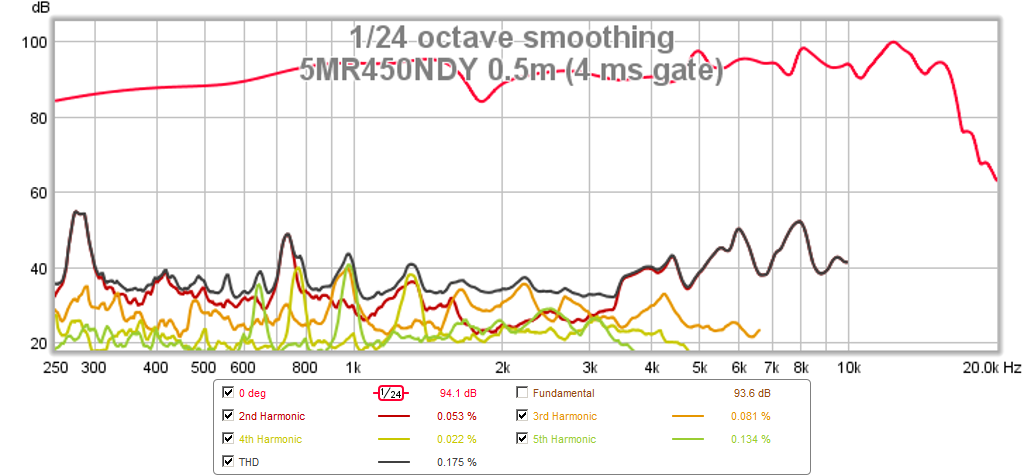
This driver sounds exceptionally clean, especially vocals, with its low harmonic distortion - most likely result of very small cone motions due to high sensitivity. This was taken at same time as 0.5m data presented earlier with drive level set at -6dB below 2.83v for equivalent SPL at 1m and 2.83v.

Attachments
I'm proud to be an Audiophile, by which I mean I care about the quality of the reproduction of the music I listen to and enjoy.
I also 'care about the quality of the reproduction of the music I listen to and enjoy' but to me the term audiophile has a negative connotation describing people that have a tendency to believe in dubious concepts instead of science.
Per members' requests for: 5dB increments, 1 meter distance, 2.83v drive level, 5 ms gating to remove low frequency room effects (don't look below 200Hz), 1/48th octave smoothing, etc. Distance measured with a ruler from driver bezel to mic at driver centerline axis. The manufacturer's rated SPL sensitivity matches pretty closely what I measure, an indication that my calibration is OK on absolute SPL scale. I am new at using gating in REW, I set to 5ms, which means 100Hz resolution, and nothing below 200Hz is any good. Let me know if this is an incorrect setting to use for displaying the data to remove room effects.
TC9FD vs 3FE22-4:
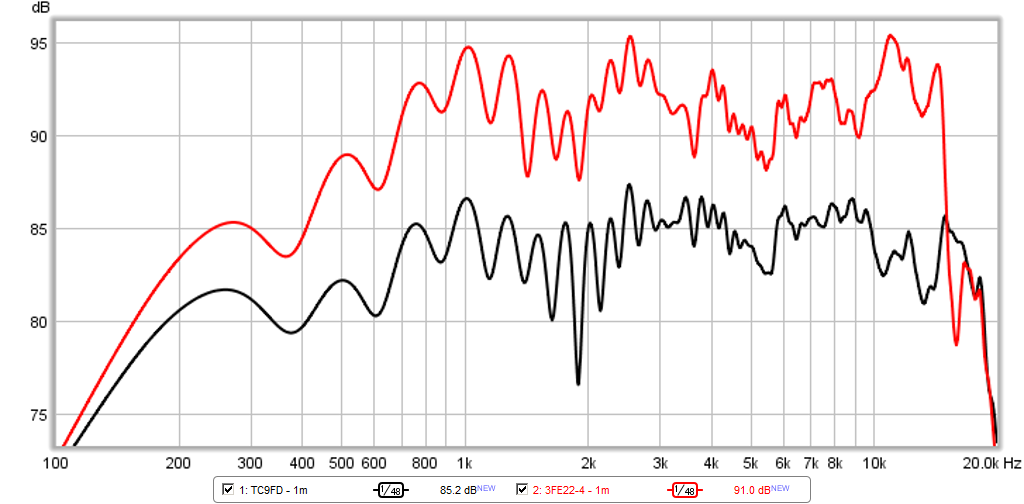
TC9FD vs 3FE22-16:
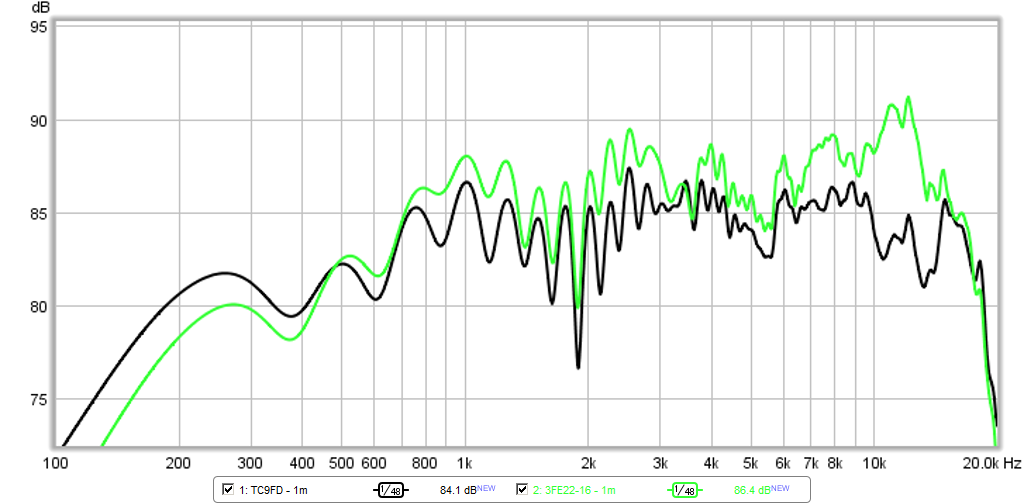
TC9FD vs RS100-4:
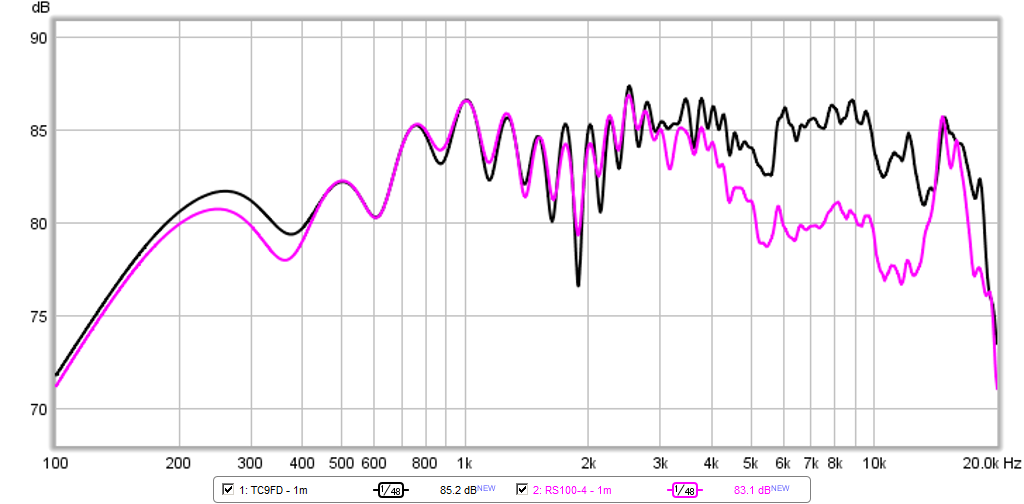
TC9FD vs RS100P-4:
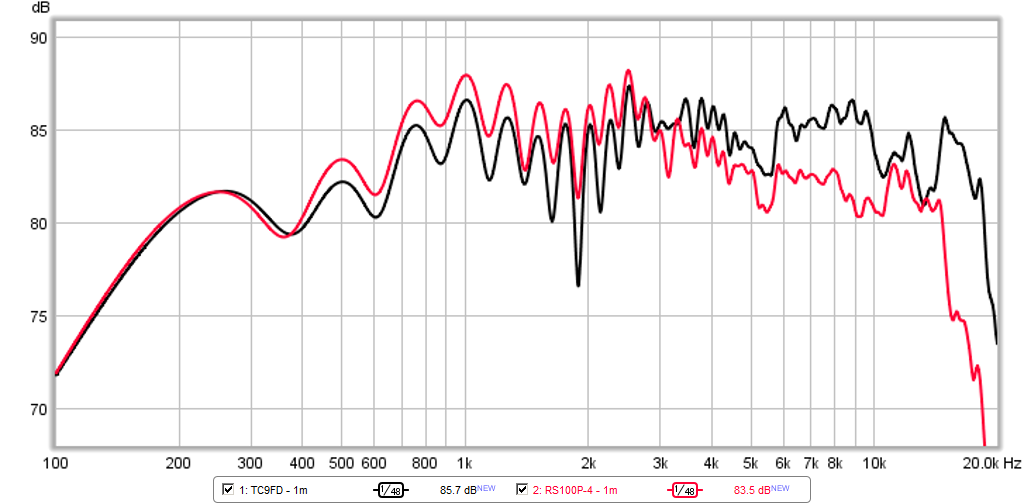
TC9FD vs CHN-70:
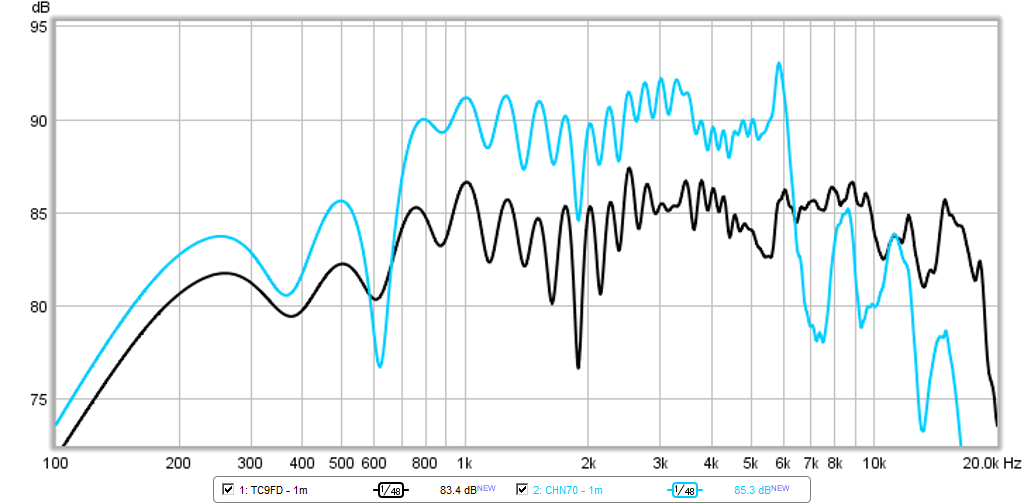
TC9FD vs PS95-8:

All these results show high correlation between drivers <4kHz; all of which bear no resemblance to results obtained using a flat baffle of any significant size. Yes, standard IEC baffle quoted for use with drivers <8" is inconveniently large.
For objective comparison that allows participating contributors to verify other's results, a common test setup must be used. I suggest a smaller simple rectangular baffle scaled down from the standard IEC baffle since topic is for drivers 4" or less.
Use of term "gate": Gating is truncation of all samples outside of gating range to zero. A jump discontinuity occurs at the gate boundary and can cause significant in frequency response measurements that go well beyond loss of low frequency information.
Gating is use of rectangular window. I suggest use of Blackman window or Blackman-Harris 4 term window, or Blackman-Harris 7 term window. These windows can be set to somewhat longer values. For example: In REW a Blackman-Harris 7 term window set to 8ms attenuates signal at 5ms by about 39dB.
Recording of music tracks for sharing as comparison is an excellent concept when constraints are used. Sure, gross differences can be heard when played back through loudspeakers, but vagaries of each speaker and room of listener intrude. Quality over ear head phones work much better, but are relatively expensive and may be exclusionary to many who may wish to participate in objective discussions. Earbuds that seal ear canal are great for these purposes. The low frequency performance of even <$10 Skullcandy earbuds rival low frequency performance of any 4" speaker, regardless of how it is mounted.
A major complaint of music recordings for comparison is choice of music. This is readily circumvented by use of convolution. Those who care to participate in this discussion need convolve impulse response of subject driver/speaker provided by the measuring party with music of own choosing.
Measurement microphones: Most have sufficiently flat response for use without correction curves; which never are applied to exported IR wave files. 1/2" diameter models such as ECM8000 should be used at 90 degrees to avoid rising response due to baffle effects of the surface area of the microphone tip.
-----------
Here is a result from my latest DSP based speaker:
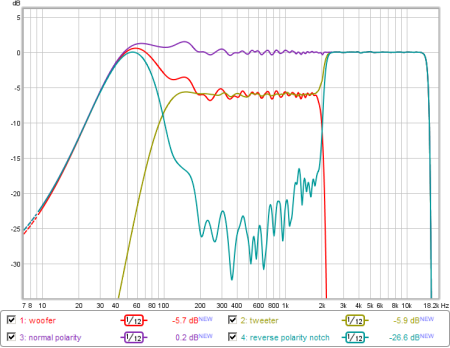
From thread that I posted:
http://www.diyaudio.com/forums/mult...sum-monopole-dipole-speakers.html#post4227362
This is very interesting indeed. I hope to have drivers boxed and on their way to you before the end of the week. Knowledge is power. This is where we gather knowledge.
Thanks xrk for your time on this.
Thanks xrk for your time on this.
That's a great idea. But, with a lot of caveats. I'd say it HAS to be the exact same setup for it to make sense. There could also be trouble lining the two recordings up exactly. A track with some sharp percussion would be best suited, I think.Here's another test for DDR differences:
Record a song with the driver with the smoothest response. Record the same song with the driver with the known best DDR.
Get both in an editing program and subtract the waves of the first from the second.
Normalise the remaining signal and listen...
We know microphones can pick up the DDR, else it wouldn't be in the recording, right?
For this test we have to pick the smooth driver, the best known DDR driver and the song with DDR info.
There are also some other minor things like amplification, DAC used etc... but I'm sure we could work out the details needed.
Especially if the claims are this big:
This test could give us another clue what it is the non DDR driver is missing.
Barleywater,
The results you linked above was at 1m and no gate so there are reflection induced dips. I repeated the measurements at 0.5m and with a 4ms gate. Those results are free of reflections as the IR shows no reflections up to 6ms. Latest results are here:
http://www.diyaudio.com/forums/full-range/270094-objective-comparison-3in-4in-class-full-range-drivers-9.html#post4231941
I have been providing sound clips of my speakers made using a digital recorder with an XY mic for years. I find them very useful to listen to in retrospect and as well as for others to get a rough idea of the sound and the balance.
Use of headphones is the best way to experience the clips and if you have studio minitor grade headphones, they provide the flattest response to not color the sound. A lot of lower cost headphones tend to have a bass heavy emphasis. I use Sony MDR V6 and find them very neutral and I think they have reach down low to easily 20Hz.
The results you linked above was at 1m and no gate so there are reflection induced dips. I repeated the measurements at 0.5m and with a 4ms gate. Those results are free of reflections as the IR shows no reflections up to 6ms. Latest results are here:
http://www.diyaudio.com/forums/full-range/270094-objective-comparison-3in-4in-class-full-range-drivers-9.html#post4231941
I have been providing sound clips of my speakers made using a digital recorder with an XY mic for years. I find them very useful to listen to in retrospect and as well as for others to get a rough idea of the sound and the balance.
Use of headphones is the best way to experience the clips and if you have studio minitor grade headphones, they provide the flattest response to not color the sound. A lot of lower cost headphones tend to have a bass heavy emphasis. I use Sony MDR V6 and find them very neutral and I think they have reach down low to easily 20Hz.
Byrtt has suggested other drivers for me to test in the future http://www.diyaudio.com/forums/full-range/270094-objective-comparison-3in-4in-class-full-range-drivers-15.html#post4233348:
1. Scanspeak Discovery 10F/
2. Fostex FF105WK
3. Visaton B80
Not sure if there has been interest by other folks for the same drivers to be tested with Byrtt's group buy.
Godzilla will soon provide:
4. Tang Band W4-1320xxx
5. Radioshack 4in
And I think one of the most highly regarded 4 inchers should also be included:
6. MA A7.3
If folks have other drivers of interest, please suggest and add to this list...
1. Scanspeak Discovery 10F/
2. Fostex FF105WK
3. Visaton B80
Not sure if there has been interest by other folks for the same drivers to be tested with Byrtt's group buy.
Godzilla will soon provide:
4. Tang Band W4-1320xxx
5. Radioshack 4in
And I think one of the most highly regarded 4 inchers should also be included:
6. MA A7.3
If folks have other drivers of interest, please suggest and add to this list...
throw one of these in - if nothing else, the front side should be reasonably weather resistant BOSS BRS40 4" Dual Cone Replacement Speaker
btw - their 6x9 whizzer speaker, although not real extended nor smooth on the top, sounded pretty good to me in a cardboard k-slotted baffe
btw - their 6x9 whizzer speaker, although not real extended nor smooth on the top, sounded pretty good to me in a cardboard k-slotted baffe
The Boss is $7 - how can you not try it? Probably high Qts door type speaker but that can work well in a Nautaloss. 100Hz to 18kHz. Inwill just have to measure the TS myself.
Besides the pretty good B80, cheaper Visatons FRS8 and FR10 might be nice to measure ($10..$15). FR10 of course needs EQ/BSC, but then it probably will show some DDR character.
Hi all, I am following this thread with great interest. A possible breakthrough in understanding loudspeaker performance? Very exciting.
Dave (Planet 10) would you please indicate to what extent you found the Scanspeak Discovery 10F/ to exhibit DDR. I have no agenda in asking for your opinion, I am merely interested in the driver for possible personal use.
Regards,
William.
Dave (Planet 10) would you please indicate to what extent you found the Scanspeak Discovery 10F/ to exhibit DDR. I have no agenda in asking for your opinion, I am merely interested in the driver for possible personal use.
Regards,
William.
Byrtt has suggested other drivers for me to test in the future http://www.diyaudio.com/forums/full-range/270094-objective-comparison-3in-4in-class-full-range-drivers-15.html#post4233348:
1. Scanspeak Discovery 10F/
2. Fostex FF105WK
3. Visaton B80
Not sure if there has been interest by other folks for the same drivers to be tested with Byrtt's group buy.
Godzilla will soon provide:
4. Tang Band W4-1320xxx
5. Radioshack 4in
And I think one of the most highly regarded 4 inchers should also be included:
6. MA A7.3
If folks have other drivers of interest, please suggest and add to this list...
How about the Fountek FR88EX?
http://www.parts-express.com/pedocs/specs/296-719-fountek-fr88ex-specifications.PDF
I remember this quote from Owen:
Here's what I tested:
Vifa TC19FD18-08
Vifa TG9FD10-04
Dayton RS75T-8
Dayton ND90-8
HiVi M3N
HiVi B3S
Tang Band W3-1053SC
Fountek FR88EX
The Fountek was actually the standout of the group, and I would have used them if it weren't for the cost, availability, and questionable build quality. They sounded incredible, measured very well, and had the best LF response for the given efficiency. If I were to build another array, it would be with those.
Cheers,
Owen
Last edited:
- Status
- Not open for further replies.
- Home
- Loudspeakers
- Full Range
- An Objective Comparison of 3in - 4in Class Full Range Drivers
